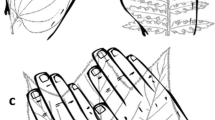Abstract
Tree growth and competition with other vegetation are strongly affected by leaf area, which can be modified by livestock browsing in silvopastoral systems. We studied the relationship of leaf area to stem diameter and sapwood area of koa (Acacia koa), a valuable hardwood tree species native to Hawaii. Because browsing alters allometric relationships, we compared harvest data with two non-destructive optical techniques (LAI-2000 canopy analyzer and photographic estimation of projected crown area). Destructive harvests of 30 trees showed that leaf area was equally well correlated with the diameter at breast height (dbh) or sapwood area of trees ranging from 2 to 16 cm in diameter, 1.3 m above ground level. Both optical techniques correlated with the leaf areas obtained by destructive analysis, but the photographic estimation of projected crown area provided more reliable estimates than the canopy analyzer. The photographic method based on projected crown area provided reliable estimates of leaf area removal within the browse zone (less than 2 m height). this method provides a simple, low-cost means of obtaining non-destructive estimates of changes in leaf area in isolated trees.
Similar content being viewed by others
References
Baskerville GL (1972) Use of logrithmic regression in the estimation of plant biomass relationships. J For Res 2: 49–53
Fownes JH and Harrington RH (1990) Modeling growth and optimal rotations of tropical multipurpose trees using unit leaf rate and leaf area index. J Appl Ecol 27: 886–896
Fownes JH and Harrington RH (1992) Allometry of woody biomass and leaf area in five tropical multipurpose trees. J Tropical For Sci 4: 317–330
Gower ST and Normal JM (1991) Rapid estimation of leaf area index in conifer and broad-leaf plantations. Ecology 72: 1896–1900
Grier CC and Waring RH (1974) Conifer foliage mass related to sapwood area. Forest Science 20: 205–206
Harrington RH and Fownes JH (1993) Allometry and growth of planted versus coppice stands of four fast-growing tropical tree species. For Ecol Management 56: 315–327
Harrington RH and Fownes JH (1995) Radiation interception and growth of planted and coppice stands of four fast growign tropical trees. J Appl Ecol 32: 1–8
Herbert DA and Fownes JH (1997) Effects of leaf aggregation in a broad-leaf canopy on estimates of leaf area index by the gap-fraction method. For Ecol Management (in press)
Kaufmann MR and Troendle CA (1981) The relationship of leaf area and foliage biomass to sapwood conducting area in four subalpine forest tree species. For Sci 27: 477–482
LI-COR Inc (1991) LAI-2000 plant canopy analyzer operating manual. LI-COR Inc., Lincoln, NE
Marshall JD and Waring RH (1986) Comparison of methods of estimating leaf-area index in old growth Douglas-Fir. Ecology 67: 975–979
Sellin A (1994) Sapwood-heartwood proportion related to tree diameter, age, and growth rate in Picea abies. Canad J For Res 24: 1022–1028
Shinozaki K, Yoda K, Kozumi K and Kira T (1964) A quantitative analysis of plant form: the pipe model theory. II. Further evidence of the theory and its application in forest ecology. Jap J Ecol 14: 133–139
Smith NJ, Chen JM and Black TA (1993) Effects of clumping on estimates of stand leaf area index using the LI-COR LAI-2000. Canad J for Res 23: 1940–1943
Snell JAK and Brown JK (1978) Comparison of tree biomass estimators — dbh and sapwood area. For Sci 24: 455–457
Snowdon P (1987) Predicting foliar biomass of Pinus radiata from basal area increment. Australian For Res 17: 277–281
Sprugel DG (1983) Correcting for bias in log-transformed allometric equations. Ecology 64: 209–210
Strachan IB and McCaughey JH (1996) Spatial and verticla leaf area index of a deciduous forest resolved using the LAI-2000 plant canopy analyzer. Forest Science 42: 176–181
Wang YS, Miller DR, Welles JM and Heisler GM (1992) Spatial variability of canopy foliage in an oak forest estimated with fish-eye sensors. For Sci 30: 854–865
Waring RH (1983) Estimating forest growth and efficiency in relation to canopy leaf area. Adv Ecol Res 13: 327–354
Warng RH, Gholz HL, Grier CC and Plummer ML (1977) Evaluating stem conducting tissue as an estimator of leaf area in four woody angiosperms. Canad J Botany 55: 1474–1477
Welles JM (1990) Some indirect methods of estimating canopy structure. Remote Sensing Reviews 5: 31–43
Welles JM and Norman JM (1991) Instrument for indirect measurement of canopy architecture. Agronomy J 83: 818–825
Author information
Authors and Affiliations
Rights and permissions
About this article
Cite this article
Grace, K.T., Fownes, J.H. Leaf area allometry and evaluation of non-destructive estimates of total leaf area and loss by browsing in a silvopastoral system. Agroforestry Systems 40, 139–147 (1998). https://doi.org/10.1023/A:1006064103080
Issue Date:
DOI: https://doi.org/10.1023/A:1006064103080




